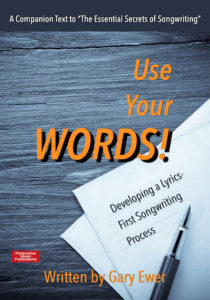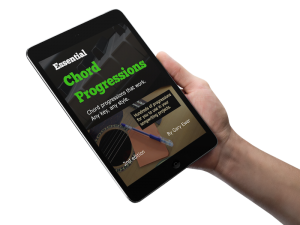If you’re a songwriter, you’re targeting an audience, whether you do it intentionally or inadvertently. You may favour country music, for example, and so if you put your songs out there for others to stream, it’s country music lovers that will be listening to them, whether you purposely target that demographic or not.
 “Use Your Words! Developing a Lyrics-First Songwriting Process” is FREE with your purchase of “The Essential Secrets of Songwriting 10-eBook Bundle. $37 USD. Immediate Download.
“Use Your Words! Developing a Lyrics-First Songwriting Process” is FREE with your purchase of “The Essential Secrets of Songwriting 10-eBook Bundle. $37 USD. Immediate Download.
When we speak of targeting an audience, though, we usually mean the purposeful act of trying to make your songs appeal to the largest segment of your intended audience. This is an area of great interest to producers, whose job it is to tailor your songs so that they largely meet the expectations of those who listen to your genre.
But it’s not easy: the target is always moving. As new performers and new songwriters enter the equation, what audiences love to hear changes a little. As producers observe what the latest “sound” is, they try to predict what the next move in that genre will be, and will then offer ideas for presenting your song that has the chance of appealing to the largest possible audience.
In that regard, as a songwriter there are several things to think about:
- Targeting an audience usually involves compromise. Your own ideas are important, but you may need to accept a different way of presenting those ideas, different from how you think the song should sound. An example: Pink Floyd’s “Another Brick in the Wall” (Part 2) had disco elements added by producer Bob Ezrin, over the objections of the band members. That sound he came up with made it hugely attractive to pop audiences of the 70s, and the song was a big hit.
- Push the boundaries of your genre gently. You may have some great ideas for what you’d like your song to sound like in the end, but keep in mind that audiences need to develop a trust in you in order to accept highly innovative ideas. Scaring off some of your audience isn’t necessarily wrong, thought, particularly if you’re building a new audience with those same ideas. An example: When The Beatles switched from being a touring rock and roll band to being a studio-based ensemble presenting highly complex music like we hear in Sergeant Pepper, they lost a segment of their following, but built an enormous new audience.
- Consider targeting between genres. If, for example, you write a pop song, but give it some country elements in the production stage, you have the makings of a good crossover tune that will appeal to a much larger audience because you’re targeting two demographics. There are lots of great examples of crossover songs: “Islands in the Stream” (country/pop, written by the Bee Gees, most famously recorded by Kenny Rodgers and Dolly Parton), “Looking’ Out For No. 1” (jazz/pop, Randy Bachman), and “Walking On the Moon” (Sting, recorded by The Police).
Many of the issues surrounding audience targeting happens at the production stage, not so much during songwriting itself. But these days, when so many songwriters are producing and recording their own songs, the two areas are divided by a very fuzzy line.
In that regard, it’s good to be thinking about how you might finesse your song and nudge it toward a specific audience, even as you’re writing it.
And be flexible with how you eventually present your song; building your fan base sometimes requires compromises that you may initially be uncomfortable with. As long as you aren’t selling your musical soul, any time you build on that fan base is almost always a good thing.
 Written by Gary Ewer. Follow Gary on Twitter.
Written by Gary Ewer. Follow Gary on Twitter.
 Looking for lists of progressions you can use in your own songs? “The Essential Secrets of Songwriting” eBook Bundle has 2 main collections, plus eBooks on how to harmonize your own melodies, and more.
Looking for lists of progressions you can use in your own songs? “The Essential Secrets of Songwriting” eBook Bundle has 2 main collections, plus eBooks on how to harmonize your own melodies, and more.











Pingback: The Daily Muse – May 18th, 2020 | All About Songwriting